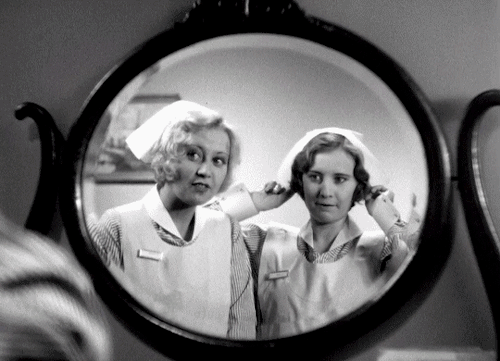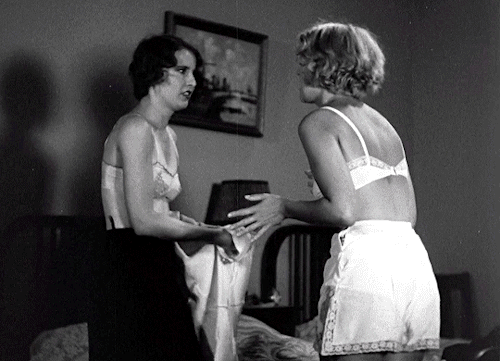“What Man Is Suitable, Doctor? She’s Never Found One. What Man Would Ever Look At Me And Say, ‘I








“What man is suitable, doctor? She’s never found one. What man would ever look at me and say, ‘I want you.’? I’m fat. My mother doesn’t approve of dieting. Look at my shoes. My mother approves of sensible shoes. Look at the books on my shelves. My mother approves of good solid books. I’m my mother’s well-loved daughter. I’m her companion. I am my mother’s servant. My mother says! My mother. My mother! MY MOTHER!” Bette Davis as Charlotte Vale in Now, Voyager (1942) dir. Irving Rapper
More Posts from Purplcx and Others










Pre-Code Hollywood refers to the era in the American film industry between the introduction of sound in the late 1920s and the enforcement of the Motion Picture Production Code (usually labeled, albeit inaccurately after 1934, as the “Hays Code”) censorship guidelines. Although the Code was adopted in 1930, oversight was poor and it did not become rigorously enforced until July 1, 1934. Before that date, movie content was restricted more by local laws, negotiations between the Studio Relations Committee (SRC) and the major studios, and popular opinion than strict adherence to the Hays Code, which was often ignored by Hollywood filmmakers. As a result, films in the late 1920s and early 1930s included sexual innuendo, miscegenation, profanity, illegal drug use, promiscuity, prostitution, infidelity, abortion, intense violence and homosexuality.






JOAN CRAWFORD as Lane Bellamy in FLAMINGO ROAD (1949) dir. Michael Curtiz

James Dean rose to fame in the 1950s, most notably for his role in 𝑹𝒆𝒃𝒆𝒍 𝑾𝒊𝒕𝒉𝒐𝒖𝒕 𝑨 𝑪𝒂𝒖𝒔𝒆, for which he became a cultural icon as the ultimate bad boy.


Norma Shearer presents the Academy Award for Best Actress to Marie Dressler, 1931






"Mother's connection with her fans was special. On the whole, their devotion to her, even when the headlines were unflattering, didn't waver. In fact, her ups and downs seemed to endear her to them all the more. They saw that she had her problems, too. There were some stars that seemed unreal, but for all her glamour, Mother retained an approachable side that her fans sensed. I think she was seen by them as Cinderella, who through a combination of luck and beauty of face and form, landed in movies. These qualities, combined with her personality, were embraced by the public and produced an enduring star.
"For her part, Mother respected her fans and recognized that the public makes a star. From the time she was very young, she appreciated the fan letters sent to her from people all over the world. In the beginning she read and answered as many pieces of mail as she could herself, but it quickly got out of hand and had to be managed by studio personnel. During a nine-month period in 1944 in which MGM monitored the fan letter flow to each of the stars, Mother and Judy Garland were shown to be ahead of the rest by far, each receiving close to 200,000 letters. After she left the studio, Mother hired a personal secretary for the first time and she dedicated a certain part of every day to signing photos, reading the mail, and dictating responses to her secretary. She took this very seriously. There were rare occasions when she was scared by a bizarre fan, but more commonly, there were special fans with whom she became comfortable enough to strike up regular correspondence, or even make telephone friends." -Cheryl Crane
LANA TURNER in THE YOUNGEST PROFESSION — 1943

Film-maker Gary Huggins inadvertently snapped up a slice of lost silent film history at an auction in a car park in Omaha, Nebraska, that was selling old stock from a distribution company called Modern Sound Pictures. Hoping to bid on a copy of the 1926 comedy Eve’s Leaves that he had spotted on top of a pile, Huggins was informed that he could only buy the whole pallet of movies, not individual cans. The upside? The lot was his for only $20.
Huggins soon discovered that his new pile of reels included 1923’s The Pill Pounder, a silent comedy that had been thought to be lost for decades. It is a short, two-reel film, shot on Long Island, New York, and directed by Gregory La Cava, best known for later classics such as My Man Godfrey (1936) and Stage Door (1937).


Maurice Goldberg ~ Olive Thomas (A camera study). Theatre Magazine vol. 29, Jan–June 1919 | src internet archive
View on WordPress









Now, Voyager (1942)

-
 jamalexlee liked this · 6 months ago
jamalexlee liked this · 6 months ago -
 charliesmydarling liked this · 7 months ago
charliesmydarling liked this · 7 months ago -
 myjoystoday reblogged this · 8 months ago
myjoystoday reblogged this · 8 months ago -
 yaoi-cthuwulhu liked this · 8 months ago
yaoi-cthuwulhu liked this · 8 months ago -
 sleepymarmot reblogged this · 8 months ago
sleepymarmot reblogged this · 8 months ago -
 thecynical-idealist liked this · 11 months ago
thecynical-idealist liked this · 11 months ago -
 lenny-kosnowski reblogged this · 11 months ago
lenny-kosnowski reblogged this · 11 months ago -
 lenny-kosnowski liked this · 1 year ago
lenny-kosnowski liked this · 1 year ago -
 manderley liked this · 1 year ago
manderley liked this · 1 year ago -
 cannibalspicnic reblogged this · 1 year ago
cannibalspicnic reblogged this · 1 year ago -
 ithinkweneedmoreviolinsontv reblogged this · 1 year ago
ithinkweneedmoreviolinsontv reblogged this · 1 year ago -
 esendoran reblogged this · 1 year ago
esendoran reblogged this · 1 year ago -
 esendoran liked this · 1 year ago
esendoran liked this · 1 year ago -
 brookpeirsunset liked this · 1 year ago
brookpeirsunset liked this · 1 year ago -
 shinygoku liked this · 1 year ago
shinygoku liked this · 1 year ago -
 academicgangster liked this · 1 year ago
academicgangster liked this · 1 year ago -
 jobey-wan-kenobi reblogged this · 1 year ago
jobey-wan-kenobi reblogged this · 1 year ago -
 thingsiwishidlearnt liked this · 1 year ago
thingsiwishidlearnt liked this · 1 year ago -
 farosdaughter reblogged this · 1 year ago
farosdaughter reblogged this · 1 year ago -
 purplcx reblogged this · 1 year ago
purplcx reblogged this · 1 year ago -
 farosdaughter liked this · 1 year ago
farosdaughter liked this · 1 year ago -
 amirathaliasgf liked this · 1 year ago
amirathaliasgf liked this · 1 year ago -
 dorothyannrichards reblogged this · 1 year ago
dorothyannrichards reblogged this · 1 year ago -
 ithinkweneedmoreviolinsontv liked this · 1 year ago
ithinkweneedmoreviolinsontv liked this · 1 year ago -
 keireiu liked this · 1 year ago
keireiu liked this · 1 year ago -
 irlydidntthinkthisthru liked this · 1 year ago
irlydidntthinkthisthru liked this · 1 year ago -
 pipe-girl-inc liked this · 1 year ago
pipe-girl-inc liked this · 1 year ago -
 womansfilm reblogged this · 1 year ago
womansfilm reblogged this · 1 year ago -
 womansfilm liked this · 1 year ago
womansfilm liked this · 1 year ago -
 redtailedhawk48 liked this · 1 year ago
redtailedhawk48 liked this · 1 year ago -
 ididntexist liked this · 2 years ago
ididntexist liked this · 2 years ago -
 jamalexlee reblogged this · 2 years ago
jamalexlee reblogged this · 2 years ago -
 cinemaaaaaaaaa liked this · 3 years ago
cinemaaaaaaaaa liked this · 3 years ago -
 irina-irina-irina liked this · 3 years ago
irina-irina-irina liked this · 3 years ago -
 thrak576isback reblogged this · 3 years ago
thrak576isback reblogged this · 3 years ago -
 thrak576isback liked this · 3 years ago
thrak576isback liked this · 3 years ago -
 dizzybrain liked this · 3 years ago
dizzybrain liked this · 3 years ago -
 virginlibertine reblogged this · 3 years ago
virginlibertine reblogged this · 3 years ago -
 virginlibertine liked this · 3 years ago
virginlibertine liked this · 3 years ago -
 katjadenauer reblogged this · 3 years ago
katjadenauer reblogged this · 3 years ago -
 katjadenauer liked this · 3 years ago
katjadenauer liked this · 3 years ago -
 monghyuns reblogged this · 3 years ago
monghyuns reblogged this · 3 years ago -
 monghyuns liked this · 3 years ago
monghyuns liked this · 3 years ago -
 oxfordsonnets liked this · 3 years ago
oxfordsonnets liked this · 3 years ago -
 bouncing-flowers liked this · 3 years ago
bouncing-flowers liked this · 3 years ago -
 orangerosary liked this · 3 years ago
orangerosary liked this · 3 years ago -
 katyadenauer reblogged this · 3 years ago
katyadenauer reblogged this · 3 years ago






